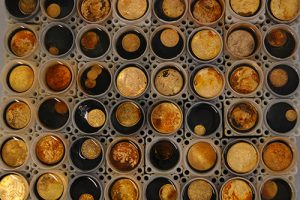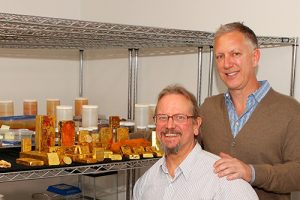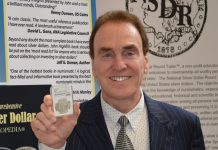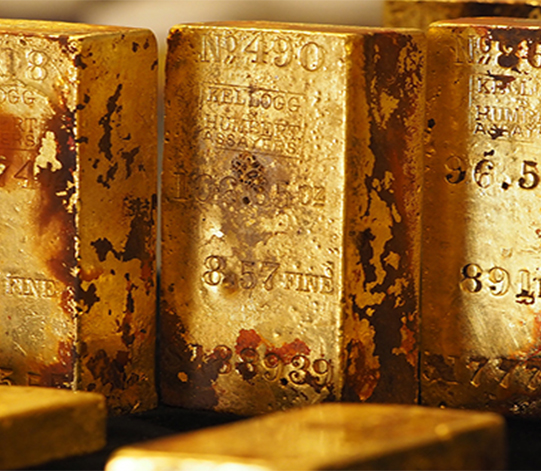
By Donn Pearlman
Since the announcement in 1988 of its discovery 7,200 feet below the Atlantic Ocean’s surface, the California Gold Rush sunken treasure of the SS Central America continues to be one of the biggest stories in numismatics around the world. The 280-foot long, three-masted sidewheel steamship has been nicknamed the “Ship of Gold”, and that fabled vessel, on its ill-fated voyage, has been described as the Titanic of her day.
There were tons of gold and 578 passengers and crew mates onboard the Central America when it encountered a hurricane on Sept. 10, 1857 during a voyage from Aspinwall (now Colón), Panama to New York City.
Two days later, on the evening of Sept. 12, she sank 160 miles off the coast of Cape Fear, North Carolina, claiming 425 lives, including that of Capt. William Lewis Herndon. This remains the worst U.S. passenger ship disaster.
Shipwreck Contributes to Panic of 1857
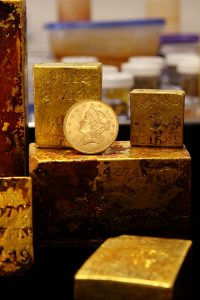
(Photo courtesy PCGS)
The huge loss of the gold cargo was one of the factors that produced the financial Panic of 1857, at a time when gold was “only” about $20 per ounce. Of course, no price tag can be placed on the loss of life from what a New York Herald newspaper headline of Sept. 19, 1857 declared to be “THE APPALLING CALAMITY”.
Historians and researchers are still uncovering the numismatic secrets of the coins, ingots, nuggets, and gold dust that have been retrieved from the ship 161 years after it sank.
“The recovered cargo is a magnificent time capsule of the commercial enterprise during the California Gold Rush,” said Bob Evans, who served as the chief scientist on each of the five summer seasons of deep-ocean expeditions undertaken since 1988 to find and recover treasure from the Central America.
The first missions, between 1988 and 1991, resulted in the recovery of more than 7,500 gold coins, as well as 532 assayers’ ingots, ranging in size from 4.95 troy ounces to 933.94 troy ounces—over 60 pounds. The scientific expedition even recovered the remains of a wooden cargo box with more than 100 Double Eagles (U.S. $20 denomination gold coins) still stacked inside.
Examining the Treasure Trove
Treasure from the last expedition in 2014, including about 3,100 U.S. gold coins and about 10,000 U.S. silver coins, is finally being examined, curated and cataloged after being sealed in 38 containers and placed in secure storage four years ago. There are also about 2,000 coins from other countries.
“In 2014, we were able to get into areas of the site with smaller deposits, passengers’ bags and parcels in debris field areas on the seabed. Every one of these is a fascinating treasure itself of the era and how the passengers lived and how they conducted daily commerce to make purchases,” explained Evans.
In late 1999, the California Gold Marketing Group purchased from the Columbus-America Discovery Group—the discoverers and retrievers of the treasure—all of the available coins, ingots, nuggets, and gold dust found on the first missions in 1988-91. The group acquired approximately 92% of the treasure. Insurance companies that had earlier waged a decade-long legal battle with Columbus-America Discovery Group over ownership of the haul received approximately 8%.
The first pieces of that treasure started reaching the marketplace in early 2000 and created an instant sensation.
Sharing the Wealth of Discovery
Dwight Manley, managing partner of the California Gold Marketing Group, created an extraordinary marketing and publicity campaign that included a traveling Ship of Gold exhibit, a 40-foot long replica of the Central America’s hull, filled with displays of millions of dollars’ worth of treasure. More than a million people have seen the exhibit nationwide and overseas over the years.
In a court-approved transaction in November 2017, Manley’s group acquired the

never-before-publicly exhibited 2014 treasure trove from Ira Owen Kane, Receiver for Recovery Limited Partnership and Columbus Exploration LLC. Manley’s group formally took possession of the treasure on Jan. 10, 2018, and that day he and Evans eagerly began opening the sealed containers and started the months-long process of examining 45 assayers’ ingots about 15,000 coins, one at a time.
The names stamped on the ingots found during the recovery missions are well known to collectors of items of the California Gold Rush era: Blake & Co.; Kellogg & Humbert; Wass Molitor & Co.; Harris, Marchand & Co.; and Justh & Hunter. These were the assayers who turned the miner’s and prospector’s gold dust and nuggets into gold bars of varying size, weight and purity, depending on what was submitted for smelting.
SS Central America Exhibit
Manley pulled the popular Ship of Gold exhibit out of dry dock earlier this year and filled it with $40 million of new cargo, a portion of the treasure recovered in 2014. This was exhibited at the February 2018 Long Beach (California) Coin, Currency, Stamp & Sports Collectible Expo, and attracted eager admirers.
“The exhibit included a type of historic SS Central America items never before displayed: leather or canvas satchels filled with more than 1,000 ounces of 1857 California gold dust, nuggets, coins and other treasure that were recovered from a safe on the sunken ship.
“They’re called ‘pokes’, and these tightly wrapped packets had been closed since before Abraham Lincoln was president,” declared Manley.
“This is truly an international discovery. In addition to more than 13,000 gold and silver United States coins, the trove includes about 2,000 coins from around the world, including two Australian sovereigns struck in Sydney in 1855 and 1856, and both are the finest known. There also are gold coins from France, including a Napoleon 20 francs, British gold sovereigns of Queen Victoria, Mexican eight escudos, Netherlands ducats, Dutch guldens and Peruvian gold, too.”
Recovery Missions
Bob Evans is the curator of the amazing treasure. He served as chief scientist and historian on all the successful recovery missions, first with Columbus-America Discovery Group between 1988 and 1991, then as a contractor with Odyssey Marine Exploration Inc. in 2014. He began working on the SS Central America project in 1983 with his neighbor, Tommy Thompson, who led the earlier expeditions for Columbus-America Discovery Group of Columbus, Ohio.
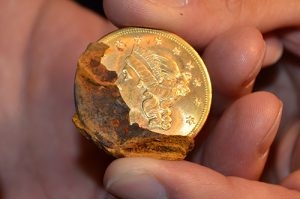
(Photo courtesy Donn Pearlman)
Thompson’s tale is one of determination to fund the initial mission and perseverance to locate and retrieve treasure, but that was followed by allegations of fraud when investors and creditors did not get paid. There was later a contempt of court ruling (and prison time) for Tommy Thompson for not revealing the location of hundreds of reportedly missing gold coins.
For Evans, though, the 35 years of work with the SS Central America projects are filled with, literally, golden memories.
“It took a lot of research and a lot of years and a lot of dreams. It was an amazing experience for all of us,” Evans recalled. “When we first saw what we later called ‘the Garden of Gold,’ gold coins and gold bars carpeting the seabed, it was a sight beyond belief. There were corals and sponges living on the gold. So we were very careful about the way we recorded and excavated the site,” he emphasized.
Paying Tribute to the SS Central America
“I have always been very mindful of the fact that 425 men lost their lives. Every year on Sept. 12, I send out a memorial email to many people to remind everyone to pause at dusk Eastern time to commemorate the moment when the Central America sank,” said Evans.
The items retrieved from the seabed give a glimpse of life during the height of the California Gold Rush, when steamships would leave San Francisco twice a month to carry passengers, crew and cargo to Panama. After a four-hour train ride across the isthmus of Panama, another ship took everyone and everything on the voyage to New York.
Sometimes, as in the case of the Central America, the ship made a stop in Havana, Cuba.
“It was massive amount of wealth coming out of California and helping to make the United States a world economic power. This was the economic lifeblood for the country, with $1 million to $2 million of gold arriving on each ship. And gold was about $20 an ounce back then,” explained Evans.
Early Commerce
He said the treasure recovered in 2014 included “street money,” the kind of coins and gold dust that people were using in 1857 for commerce.
“More than 100 tiny California fractional gold pieces were recovered, and U.S. Mint coins of every denomination as well as world coins. It’s the kind of ‘street money’ used to pay for food, lodging or an evening’s entertainment. It takes you right there (to 1857 California). I’ve never experienced anything like this before when looking at these coins,” he stated.
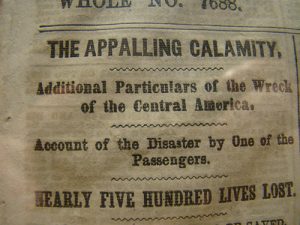
(Photo courtesy Donn Pearlmann)
“When I look at the recovered pokes that contain gold dust, nuggets or coins, I think to myself that someone on horseback carried them 161 years ago, and this is the first time since then that they have been opened. It’s very exciting.”
Manley agreed: “It is amazing to watch Bob carefully unwrap the pokes so we can see what has been inside since James Buchanan was president in 1857.”
Is there still more treasure onboard or on the ocean floor near the Central America Evans says he believes there are still some coins and perhaps ingots to be found, but he has not discovered any records or other evidence to support speculation by some that a secret military shipment of tons of gold was on the ship when she sank.
Many people dream of finding treasure. It is nice to know some people get to live their dreams.


